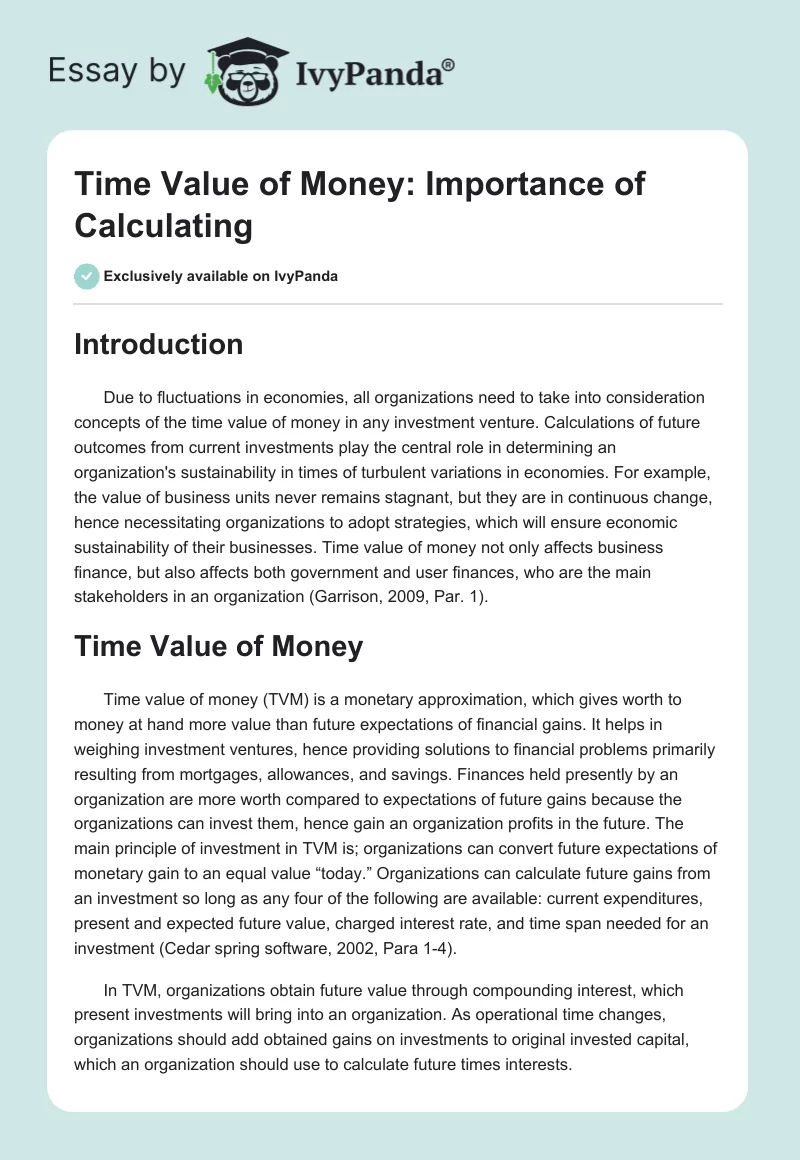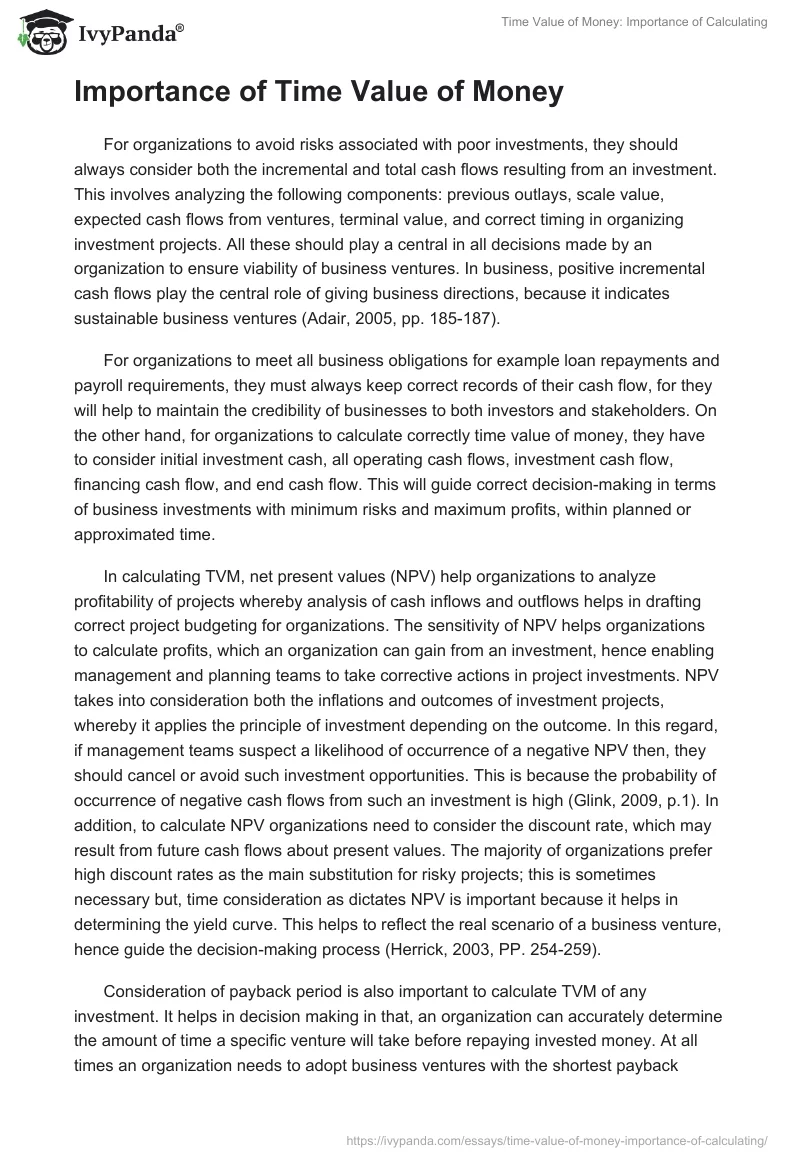Introduction
Due to fluctuations in economies, all organizations need to take into consideration concepts of the time value of money in any investment venture. Calculations of future outcomes from current investments play the central role in determining an organization’s sustainability in times of turbulent variations in economies. For example, the value of business units never remains stagnant, but they are in continuous change, hence necessitating organizations to adopt strategies, which will ensure economic sustainability of their businesses. Time value of money not only affects business finance, but also affects both government and user finances, who are the main stakeholders in an organization (Garrison, 2009, Par. 1).
Time Value of Money
Time value of money (TVM) is a monetary approximation, which gives worth to money at hand more value than future expectations of financial gains. It helps in weighing investment ventures, hence providing solutions to financial problems primarily resulting from mortgages, allowances, and savings. Finances held presently by an organization are more worth compared to expectations of future gains because the organizations can invest them, hence gain an organization profits in the future. The main principle of investment in TVM is; organizations can convert future expectations of monetary gain to an equal value “today.” Organizations can calculate future gains from an investment so long as any four of the following are available: current expenditures, present and expected future value, charged interest rate, and time span needed for an investment (Cedar spring software, 2002, Para 1-4).
In TVM, organizations obtain future value through compounding interest, which present investments will bring into an organization. As operational time changes, organizations should add obtained gains on investments to original invested capital, which an organization should use to calculate future times interests.
Importance of Time Value of Money
For organizations to avoid risks associated with poor investments, they should always consider both the incremental and total cash flows resulting from an investment. This involves analyzing the following components: previous outlays, scale value, expected cash flows from ventures, terminal value, and correct timing in organizing investment projects. All these should play a central in all decisions made by an organization to ensure viability of business ventures. In business, positive incremental cash flows play the central role of giving business directions, because it indicates sustainable business ventures (Adair, 2005, pp. 185-187).
For organizations to meet all business obligations for example loan repayments and payroll requirements, they must always keep correct records of their cash flow, for they will help to maintain the credibility of businesses to both investors and stakeholders. On the other hand, for organizations to calculate correctly time value of money, they have to consider initial investment cash, all operating cash flows, investment cash flow, financing cash flow, and end cash flow. This will guide correct decision-making in terms of business investments with minimum risks and maximum profits, within planned or approximated time.
In calculating TVM, net present values (NPV) help organizations to analyze profitability of projects whereby analysis of cash inflows and outflows helps in drafting correct project budgeting for organizations. The sensitivity of NPV helps organizations to calculate profits, which an organization can gain from an investment, hence enabling management and planning teams to take corrective actions in project investments. NPV takes into consideration both the inflations and outcomes of investment projects, whereby it applies the principle of investment depending on the outcome. In this regard, if management teams suspect a likelihood of occurrence of a negative NPV then, they should cancel or avoid such investment opportunities. This is because the probability of occurrence of negative cash flows from such an investment is high (Glink, 2009, p.1). In addition, to calculate NPV organizations need to consider the discount rate, which may result from future cash flows about present values. The majority of organizations prefer high discount rates as the main substitution for risky projects; this is sometimes necessary but, time consideration as dictates NPV is important because it helps in determining the yield curve. This helps to reflect the real scenario of a business venture, hence guide the decision-making process (Herrick, 2003, PP. 254-259).
Consideration of payback period is also important to calculate TVM of any investment. It helps in decision making in that, an organization can accurately determine the amount of time a specific venture will take before repaying invested money. At all times an organization needs to adopt business ventures with the shortest payback periods in order to lessen limitations that may result from investments. Although this method is good, it has many limitations, in that it lays less emphasis on time value of money. When using this approach in decision making organizations should take precautions by incorporating other methods such as the internal rate of return to ensure assumptions made are correct. Discounted payback period helps to account for all business flaws, which may occur by considering inflation and the amount of interest investment will give an organization. In addition, payback calculations are important because they can help managements to evaluate various business ventures hence, make correct investment choices, which will ensure the viability of an enterprise (Pisello, 2005, Par. 1-5).
Conclusion
In conclusion, it is very essential to correctly approximate the time value of money because it helps in giving clear outcomes of ventures an organization seeks to invest in. In addition, correct calculations can help an organization determine the amount of time it will take an organization to realize expected profits, hence take correct measures to avert associated risks.
Reference List
Adair, T. A. (2005). Corporate finance demystified. Columbus: McGraw-Hill.
Cedar spring software. (2002). Time value of money. Get objects. Web.
Garrison, S. (2009). Time value of money. Study finance. Web.
Glink, I. (2009). Calculating the net present value (NPV) of a foreclosure vs. a loan modification. Money watch. Web.
Herrick, D. F. (2003). Media management in the age of giants: business dynamics of journalism. New Jersey: Wiley-black well.
Pisello, T. (2005). Why pay back periods are important. Sap tips. Web.


